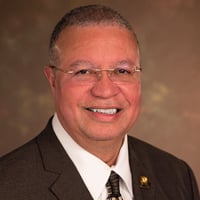By Terry Carter
Herbert Dixon had already been eligible to retire for six years before he finally did in 2015, after 30 years on the District of Columbia Superior Court—the district’s version of a state trial court. But the judge stayed on longer because he was having too much fun changing the way cases are tried by bringing high technology into the courtroom.
He likes showing young pups and others better ways to practice law.
At 69, Dixon doesn’t fit that epigram about old dogs and new tricks. He’s still proselytizing about high tech in courthouses and courtrooms, and he predicts its future. He’s still trying some cases as a senior judge, is a member of the ABA Board of Governors and now a Legal Rebels Trailblazer, and he’s engaged in so many other endeavors that he never seems to be (under immutable laws of motion) a body at rest.
He led the way in getting the Washington, D.C., trial court of general jurisdiction to adopt electronic filing and then to develop high-tech courtrooms that would change how a lot of lawyers practice law. For example, they would see that large, flat-screen image displays could make evidence much easier to understand and remember.
In 2007, Dixon started a technology column in the Judges’ Journal, the quarterly publication of the ABA Judicial Division. The headline he wrote for his upcoming column shows his own fun and interest that he hopes to share: “#VR#AI#IOT Are Coming to a Courthouse Near You!”
The first string of characters is an assortment of abbreviations for virtual reality, artificial intelligence and the internet of things. The judge then explains how developments in these areas are ready for court.
• VR: Jurors who wear virtual reality headsets can take a 3D walk around a crime scene.
• AI: Evidence may be presented from crashes that involve self-driving cars.
• IoT: Smartphone apps and other GPS technology can solve a vexing problem for judges: Where at this moment is a particular lawyer who is supposed to be in the courtroom?
Dixon was appointed to a 15-year term on the bench by President Ronald Reagan in 1985 and then reappointed by President Bill Clinton in 2000. The Savannah, Georgia, native received a Bachelor of Science degree in electrical engineering from Howard University and a JD from Georgetown University Law Center.
The judge was intrigued when the Delaware Superior Court became the first state court to adopt an electronic filing and docketing system in 1991, which began with insurance cases and eventually expanded to all civil matters.
Through his efforts and urging throughout a number of years (the greatest pushback came from the IT department), the D.C. Superior Court launched its own e-filing pilot program in 2001. In 2008, he pushed for and was given responsibility for developing a high-tech courtroom in the building, which launched in 2010. Three such courtrooms exist there now.
“What took me to where I am now [pushing courtroom technology] was that I wasn’t satisfied by the law itself,” Dixon says. “When nieces and nephews and others had problems with math, science and physics, I was always the one they’d come to. Turns out I was a good teacher.”

Judge Herbert Dixon
Herbert Dixon is a senior judge with the District of Columbia Superior Court. He served two 15-year terms on the court, first nominated by President Ronald Reagan and then reappointed by President Bill Clinton. He also serves on the ABA Board of Governors, and is a past member of the ABA Journal’s Board of Editors.